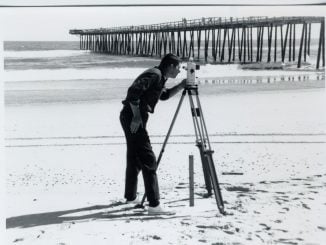
August 6, 1944
Flying Ace George Preddy of Greensboro
Greensboro native George E. Preddy Jr., the top P-51 Mustang ace during World War II, downed six planes on a single day, earning a Distinguished Service Cross—the nation’s second highest award—in the process. Preddy was a barnstormer pilot before the war. He tried three times to become a naval pilot but was rejected because of health problems. The Army Air Corps accepted Preddy, placing him on a waiting list for a cadet class. In 1940, he joined the National Guard, and he received his wings in December 1941. After a training accident and a three-month recovery, he returned to the United States, and was eventually assigned to a squadron that was sent to Great Britain. He shot down his first plane in December 1943. In April 1944, his squadron received the P-51 Mustang, and Preddy named his the Cripes A’Mighty. While flying in pursuit of a German plane during the Battle of the Bulge, Preddy was accidentally shot down by friendly ground fire. He is buried at the Lorraine American Cemetery in France.
August 6, 1945
Enola Gay Bombadier Thomas Ferebee of Mocksville
Major Thomas Wilson Ferebee, a U.S. Army Air Corps bombardier and Mocksville native, dropped the atomic bomb on Hiroshima, Japan. The 12-man crew aboard the B-29 bomber, the Enola Gay, took off for Hiroshima at 2 a.m. from Tinian Island in the western Pacific. Ferebee, then 26 and a veteran of 64 combat missions, was napping and initially did not hear the pilot, Colonel Paul Tibbets Jr., brief the crew about their top-secret mission. Approaching Hiroshima, Ferebee activated the plane’s automated Norden bombsight, centered its crosshairs on the Aioi Bridge and called “bomb away.” It was 8:15 a.m. The 9,000-pound bomb, nicknamed “Little Boy,” tumbled from the plane’s belly and sped six miles to its target below. Forty-three seconds later, the bomb detonated, instantly killing 70,000 people. On August 9, another bomber crew dropped a second atomic bomb on Nagasaki. Six days later, the Japanese government surrendered unconditionally, ending World War II. Ferebee retired from the U.S. Air Force in 1970 and died in 2000. He never expressed regret about dropping the A-bomb, maintaining that it saved more lives than it took by ending the war sooner.
August 6, 1918
World War I U-Boat Casualty Off Cape Hatteras
Diamond Shoals Lightship No. 71 was shelled by a German submarine while anchored off Cape Hatteras. The lightship, which had just sent a wireless message about the submarine’s shelling of the USS Merak, served as a beacon at sea to warn mariners of the dangerous shoals that formed off the coast. As a result of the blows, the ship quickly sank. The lightship’s crew of 12 rowed 10 ten miles to shore in a small lifeboat. “We succeeded in getting away and never did mortal man row as we did that afternoon,” the chief engineer later recounted. The lightship was quickly replaced by another that was kept to use as a backup. The German submarine that took the ship down, U-140, also claimed the Standard Oil tanker O.B. Jennings 100 miles off the Virginia coast and the four-masted schooner Stanley M. Seaman off Cape Hatteras in the each of the two previous days. Following the sinking of the lightship, the submarine was spotted just a half mile of the North Carolina coast in busy shipping lane.
August 9, 2003
Pisgah Covered Bridge Rebuilt After Flood

A flood washed away the Pisgah Covered Bridge. The bridge spanned the West Fork Branch of the Little River in the Uwharrie National Forest south of Asheboro. It was built at a cost of $40 by J. J. Welch around 1910. Welch constructed a number of other covered bridges in the area. Since rebuilt, the Pisgah Covered Bridge is the only surviving covered bridge in Randolph County, which once had more covered bridges than any other county in North Carolina. Along with the 1895 Bunker Hill Covered Bridge, near Claremont in Catawba County, it is one of only two left in North Carolina. The Bunker Hill Covered Bridge is similar to the Pisgah bridge in form and materials, but it was constructed as an open span bridge and covered in 1900. Wooden bridges were covered to protect their heavy-timber framing from exposure to the elements. This protection greatly extended the life span of the bridge. Thousands of covered bridges were constructed in the United States but fewer than 800 remain. The Pisgah Covered Bridge is open to the public from dawn to dusk and is located at 6925 Pisgah Covered Bridge Road.
August 9, 1751
State’s First Newspaper Issued in New Bern
James Davis issued the North-Carolina Gazette, the first newspaper to appear in the colony. The newspaper wasn’t Davis’ first foray into publishing; he had established the colony’s first printing press two years earlier in New Bern. In that capacity he printed currency and various official publications. The newspaper, unlike modern print papers, did not have headlines or much local news. It focused mostly on international news and the arrivals and departures of ships. The Gazette was supposed to have been published weekly but, from the issues that survive, it appears to have had no regular schedule and wasn’t published at all between 1759 and 1768. A terrible storm destroyed Davis’s print shop in 1769, forcing him to salvage what equipment he could and rebuild his business. The Revolutionary War also presented Davis with problems in regularly issuing his Gazette, making it difficult for Davis to get paper and forcing his son, who was his assistant, to serve in the army. Davis served as the colony’s public printer until 1782 and he kept issuing the Gazette until just before his death in 1785. The paper appeared in another form between 1786 and 1798, when it was used by another printer to promote the Bill of Rights and other causes.
August 12, 1989
Haywood County Plott Hound named State Dog
The Plott Hound was officially designated as the State Dog. One of only four dog breeds native to the United States, the breed was developed in Haywood County by the Plott family. The foundation stock for the dogs that became Plott Hounds came to America with Johannes George Plott in 1750. The Plotts bred hard-working, tenacious and loyal dogs that would hunt bears and wild boars with boundless courage. Plott enthusiasts describe the breed as bold and energetic hunting dogs, gentle with people and loyal to their owners. The breed was popular across the region as early as the mid 1800s; people from near and far would travel to Haywood County to get puppies from the Plott family. The dogs, once black, brown or brindle, are now usually brindle—meaning stripes of varying color. They stand 20 to 25 inches at the shoulder, weigh about 45 to 55 pounds and are strong and fast. The Plott Hound has a distinctive high-pitched bark that is effective in alerting hunters to treed prey. The American Kennel Club recognized the Plott Hound as a distinctive breed in 1998.
Source: North Carolina Department of Cultural and Natural Resources



